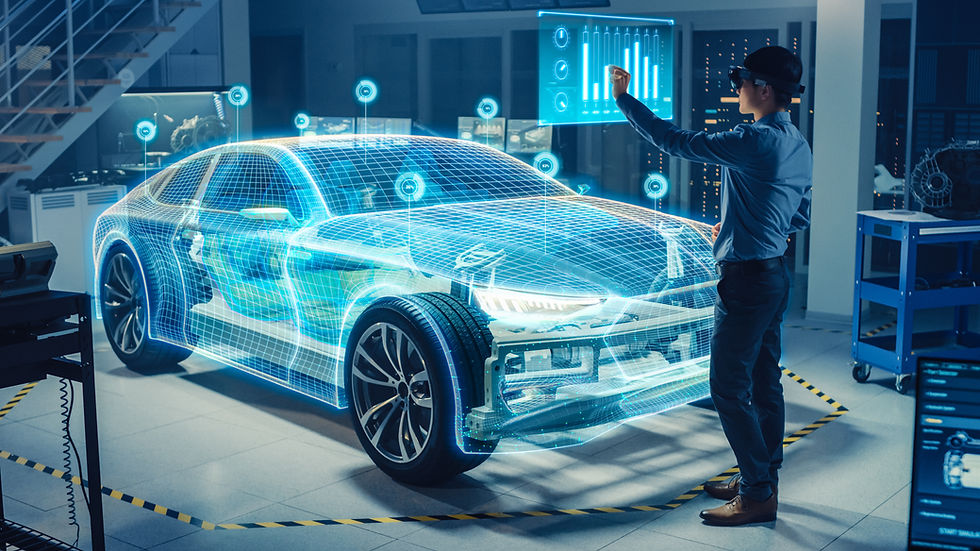Simulating Safety: How VR is Shaping the Future of Automotive Design and Crash Testing
- Dr. R. Ryan Rider

- Sep 22, 2023
- 3 min read
Updated: Mar 21
In an era of rapid technological advancement, the automotive industry is undergoing a revolutionary transformation. One of the most remarkable innovations in this sector is the integration of Virtual Reality (VR) into automotive design and crash testing processes. This convergence of automotive engineering and virtual reality is not just about enhancing the user experience or entertainment; it's about saving lives and making our roads safer than ever before. In this article, we delve into how VR simulations are revolutionizing automotive safety, from the early design stages to rigorous crash testing, and the profound impact they are having on the future of road safety.

Designing for Safety: The VR Advantage
Gone are the days when vehicle design was limited to sketches on paper and clay models. Today, automotive manufacturers are harnessing the power of VR to create virtual prototypes that enable them to optimize safety features before a single physical component is manufactured. VR simulations provide designers and engineers the ability to explore countless design variations and evaluate their impact on safety parameters. This process is not only efficient but also cost-effective, as it reduces the need for physical prototypes and extensive testing.
With VR, designers can step into a virtual vehicle, examine its interior and exterior from every angle, and even simulate real-world scenarios, such as collisions, to assess potential safety risks. This proactive approach to design allows manufacturers to identify and rectify potential safety flaws early in the development process, resulting in vehicles that are inherently safer by design.
Crash Testing in a Virtual Environment
Traditionally, crash testing involved the use of physical test dummies and expensive, one-time-use vehicles. These tests were conducted to assess the impact of collisions on both the vehicle and its occupants. While real-world crash tests remain essential, VR has introduced a game-changing element: the ability to conduct virtual crash tests before any physical components are built.
Using advanced VR simulations, engineers can replicate a variety of crash scenarios, from head-on collisions to side impacts, with incredible accuracy. These simulations take into account factors such as vehicle speed, impact angles, and occupant positions. By assessing how a vehicle behaves during these virtual crashes, engineers can fine-tune safety features such as airbags, seatbelt systems, and crumple zones to maximize protection for occupants.
This virtual crash testing not only reduces the need for costly physical prototypes but also allows for rapid iterations and adjustments based on test results. As a result, manufacturers can iterate and improve safety features in a fraction of the time it would take using traditional methods.
Training and Education for Safer Roads
The benefits of VR in automotive safety aren't limited to the design and engineering processes. VR is also making a significant impact on training and education for both engineers and emergency responders. Automotive engineers can use VR simulations to gain insights into the effects of different safety features, allowing them to design more effective systems. Additionally, first responders can use VR to simulate accident scenes and practice extrication procedures, ensuring they are well-prepared to handle real-life emergencies.
Furthermore, VR is increasingly being integrated into driver education programs. New drivers can benefit from immersive simulations that expose them to various hazardous scenarios, such as adverse weather conditions, distracted driving, and sudden obstacles. These simulations provide a safe and controlled environment for novice drivers to develop their skills, make split-second decisions, and learn the importance of defensive driving.
Challenges and the Road Ahead
While the potential of VR in shaping the future of automotive safety is immense, there are still challenges to overcome. One significant hurdle is the need for highly accurate virtual models that replicate real-world physics with precision. Ensuring that the virtual environment behaves in a physically accurate manner is crucial for reliable results. Additionally, as VR technology continues to evolve, ensuring compatibility and standardization across various platforms and manufacturers will be vital to its widespread adoption.
Final Thoughts
Virtual Reality has ushered in a new era in automotive safety, enabling manufacturers to design safer vehicles and conduct thorough crash testing in virtual environments. This integration of VR into the automotive industry is not only enhancing efficiency and reducing costs but, more importantly, it is saving lives. As technology continues to advance and VR simulations become even more accurate, we can expect even greater strides in the realm of automotive safety.
From designing vehicles that are inherently safer to training the next generation of drivers and emergency responders, VR is shaping the future of road safety one simulation at a time. As we look ahead, the collaboration between virtual reality and automotive design is set to create a world where accidents are minimized, injuries are reduced, and our roadways are safer for everyone.




Comments